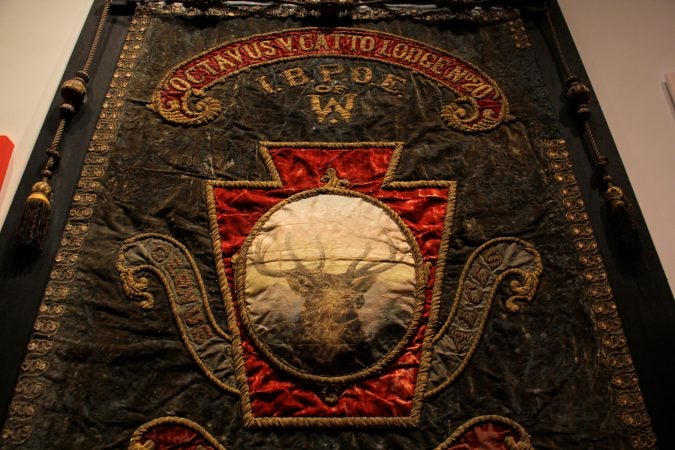Philly History Museum offers primer on Octavius Catto’s life
Catto died too young to leave behind much in the way of material objects. The exhibition is document-heavy, with reproductions of historic archives and imagery.
-

A new exhibit at the Philadelphia History Museum tells the story of Octavius Catto, a civil rights activist who was shot to death on Election Day 1871. (Emma Lee/WHYY)
-

A banner commemorates the 1903 opening of the Octavius V. Catto Elks Lodge in Philadelphia. (Emma Lee/WHYY)
-

A scale model of the Octavius Catto Memorial at City Hall, designed by New York sculptor Branley Cadet, is now part of the Philadelphia History Museum's permanent collection. (Emma Lee/WHYY)
-

A timeline maps out the short but eventful life of Octavius Catto, who was 32 when he was shot to death. (Emma Lee/WHYY)
-

The Pennsylvania National Guard awards the Major Octavius V. Catto Medal annually to a deserving PNG soldier and airman. (Emma Lee/WHYY)
The city of Philadelphia — through the urging of Mayor Jim Kenney — recently took the unusual step of erecting a statue at a prominent spot in front of City Hall in honor of someone few know by name.
This isn’t Ben Franklin, or Joe Frazier, or Martin Luther King Jr. This is Octavius Catto, who remains a mystery to many.
Enter the Philadelphia History Museum at the Atwater Kent.
This weekend, the museum at Seventh and Arch streets will turn a small room into, effectively, a CliffNotes gallery about Catto’s life.
Catto was a free African-American living in Philadelphia when many African-Americans were slaves. He was well-educated, a graduate of Cheyney University working as a teacher. He started a black military unit during the Civil War and a black baseball league, and he fought for the right of black people to ride the city’s horse-drawn trolley cars.
He did all that — and more — before he was 32 years old. In 1871, Catto was shot in the street on Election Day while rallying to get people to the polls.
His funeral was a huge public event.
“His funeral — other than Abraham Lincoln’s — was the largest funeral people attended,” said museum CEO Charles Croce. “That’s fascinating to me. We know Abraham Lincoln, but who is Octavius Catto?”
To help answer that question, the museum contributed to the School District of Philadelphia’s new curriculum that’s being used to teach students about Catto.
Catto died far too early to leave behind much in the way of material objects. The exhibition is document-heavy, with reproductions of historic archives and imagery that illustrate key moments of his life.
There are some objects on display, including a vintage banner from the Elks Lodge, of which Catto was a member; and a baseball bat believed to have been used by Catto.
Croce wants the narrative of Catto’s life to come through, because his story of 150 years ago is still relevant.
“For someone shot down, in the street, by two white men who went to trial and were never prosecuted — the stories tend to sound like today’s stories in the news,” he said. “This is a story we feel needs to be told and Philadelphians need to look at with pride.”
“Taking a Stand for Equality: Octavius E. Catto” will be on display until March, with the possibility of an extension.
WHYY is your source for fact-based, in-depth journalism and information. As a nonprofit organization, we rely on financial support from readers like you. Please give today.





